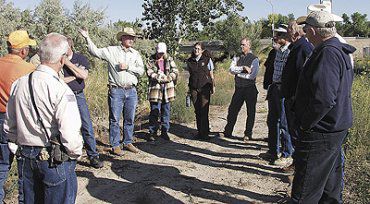The Skyline Cooperative Weed Management Area (CWMA) held a public tour of successful weed treatment projects in Carbon and Emery counties on Sept. 3. The tour started directly behind Albertsons on the Price River.
A combined group from the Utah Department of Transportation, USU Extension Service, Utah Division of Forestry, Fire and State Lands, and the Price River Conservation District have undertaken a project to remove the Russian olive trees from the banks of the Price River. The group used funds from a National Fire Plan grant obtained from the Bureau of Land Management to get the project started. They cut the trees down and then treat the trunks with 2-4D herbicide at a rate of 1cc per trunk inch to help prevent re-sprouting. It appears to have been fairly successful with limited regrowth. They do however anticipate repeat treatments on a yearly basis for six to seven years to treat regrowth caused from the seed bed. There are plans to do the other side of the river in September or October In the future they would like to treat the whole Price River from Price to Helper.
The group then traveled to another location in Carbon County where more Russian olive trees are being treated. At this site results from a study conducted in both Carbon and Emery counties, on treatment methods and treatment seasons were discussed.Carbon County used the herbicide 2-4D and Emery County used Roundup. Both methods were equally successful. The study indicated treatings from May to October obtained the best results.
In Emery County the tour focused on the treatment of tamarisk plants. Two stops were made, one at Fullers Bottom and one at Buckhorn Draw on the San Rafael Swell.
At Fullers Bottom a biological method is being used to treat the tamarisk plants.
Five to six thousand tamarisk leaf beetles were released at this site three years ago and now show visible signs of attack by the insects.
The beetles are specific to the tamarisk and will not attack any other vegetation.
The final stop was Buckhorn Draw and a tour of work done over the summer through the Scout-sponsored ‘Order of the Arrow'(OA) tamarisk removal and herbicide treatment project. During the project the OA members cut tamarisk plants with pruners and handsaws.
Then approximately 100 state, county and federal employees that supported the project applied Garlon 4 herbicide to the cut stumps to prevent resprouting.
The project was very successful and there are very few signs of regrowth at this time.
This Buckhorn site along with an area around Joe’s Valley Reservoir and Millsite Reservoir were all part of the OA project.
Weed tour shows hope for eradication of noxious weeds and trees

"Roger Barton explains the Russian olive removal project along the Price River."
